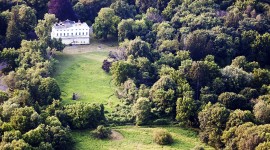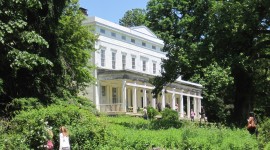Building Consensus About Bridging a Divide—The Nature-Culture Symposium at the Jay Heritage Center
The Jay Heritage Center in Rye, New York, pulled double duty on June 4, 2011—it was both site for the daylong symposium “Bridging the Nature-Culture Divide” and a leading example of conference’s topic. The 23-acre, 
Symposium, photo courtesy of Suzanne Clarycenturies old site on the historic Boston Post Road was at its nadir in 1992 when the grassroots actions of more than 62 historic and environmental groups and the five founding women of the Jay Coalition (and today's Jay Heritage Center), intervened to save it. The Center’s determination and progress was a frequent reference point in examining the challenges and opportunities that come with balancing landscape design and environmental stewardship.
Six internationally-recognized speakers, each with substantive experience working with nationally-significant historic sites, posed questions and presented ideas, findings and case studies. Among the nearly 70 attendees were historic site directors, several local teachers, and an array of landscape architects and allied professionals from around the country.
TCLF President and Founder Charles Birnbaum opened the symposium with remarks that applauded the Center for its deliberate and informed stewardship and fundraising prowess. As a prelude to the day’s presentations, he set the stage by putting forth probing challenges in the debate. As a transition to the second presentation, by Charlotte, VT-based landscape architect Patricia O'Donnell, Birnbaum touched upon the history of the Jay Property, later opening the floor to discussion of what lay ahead in managing this landmark park in a sustainable way. O’Donnell next presented a detailed analysis of the landscape’s evolution over time, concluding in a presentation highlighting treatment and management recommendations for the Jay landscape, which also drew on her national experience in such projects as the U.S. Capitol Grounds and Vizcaya Museum and Gardens.


(upper) Peter G. Rolland, TCLF Board Member
Suzannne Clary, Rye City Council Member Suzanna
Keith and Charles Birnbaum; (lower) TCLF Board
Members Carolyn Bennett, Bill Quinlan, and Meredith
Bzdak with TCLF Staff Member Melanie Macchio.
Photos courtesy of Suzanne ClaryCalifornia-based landscape architect Cheryl Barton promoted the value of historic photographs in the design process, demonstrating their use in her work at the Sutro Baths and Cavallo Point in San Francisco and the South Lawn of the University of Virginia in Charlottesville. Her modern design representations were informed by historic images of landscape structures such as turn-of-the-century bathhouses, tennis courts, and an African American gravesite.
Boston-based Douglas Reed focused on Bennington College and the Clark Art Institute, campuses where the landscape designs serve to interpret the meaning place for students and visitors. Thomas Woltz, of Nelson Byrd Woltz with offices in Charlottesville, VA and New York City, discussed the treatment plans for active agricultural sites in Virginia and New Zealand in emphasizing the importance of collaboration between disciplines.


(upper) Symposium speakers Cheryl Barton and
Thomas Woltz; (lower) Participants commune on the
lawn.Author and photographer Rick Darke presented powerful images of landscapes and terrains including Fallingwater where sensitive “edits” or choices of appropriate local plant materials helped establish healthy, low maintenance environments. He contrasted these with examples of woodlands over-browsed by deer and sites where a “let nature take its course” attitude had resulted in poor biodiversity and monocultures of less desirable trees and plants.
TCLF and the Jay Heritage Center co-sponsored Bridging the Nature-Culture Divide with support from the New York Chapter of the American Society of Landscape Architects (ASLA), The Preservation League of New York State, and The New York Historical Society and sponsorship from Con Edison. The symposium was held in the Jay estate’s carriage house, also the home of the Landslide 2010 “Every Tree Tells a Story” traveling photographic exhibition.
Thanks to all the speakers, attendees, and the Jay Heritage Center—and the good weather for the site walking tour—for collaborating to make this a productive and exciting event.





